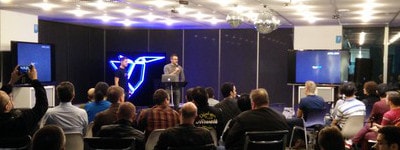TCP, HTTP &
mobile Performance



Our next event is on the 21st of May.
Speakers:
A short trip into the lower layers of networking and their implications for initial page load performance over mobile carriers. You will hear about RTT, congestion windows, chunked transfer encoding, how HTTP2 will help and how to utilise that knowledge when developing PHP applications served to mobile devices.
With all the bells and whistles of a CMS, we forget about simple, static HTML. In this talk reintroduce you to the concept of a static site, how to build one (using PHP of course) and deployment techniques to manage it. Examples include using sculpin, markdown, twig, CI and CDN's.
A common case
first content after ~4s
75% of users have stated that they'd never come back to a page they had to wait for for more than 4s
Google
loss of flow of thoughts occurs after 1s
Jakob Nielson Group



Our next event is on the 21st of May.
Speakers:
A short trip into the lower layers of networking and their implications for initial page load performance over mobile carriers. You will hear about RTT, congestion windows, chunked transfer encoding, how HTTP2 will help and how to utilise that knowledge when developing PHP applications served to mobile devices.
With all the bells and whistles of a CMS, we forget about simple, static HTML. In this talk reintroduce you to the concept of a static site, how to build one (using PHP of course) and deployment techniques to manage it. Examples include using sculpin, markdown, twig, CI and CDN's.
So what if?
first content after ~1s




Our next event is on the 21st of May.
Speakers:
A short trip into the lower layers of networking and their implications for initial page load performance over mobile carriers. You will hear about RTT, congestion windows, chunked transfer encoding, how HTTP2 will help and how to utilise that knowledge when developing PHP applications served to mobile devices.
With all the bells and whistles of a CMS, we forget about simple, static HTML. In this talk reintroduce you to the concept of a static site, how to build one (using PHP of course) and deployment techniques to manage it. Examples include using sculpin, markdown, twig, CI and CDN's.
Or maybe?
first content after ~1s
keeping the user entertained
The Page Speed Problem
The Page Speed Problem
network time = amount of data / bandwidth
relatively complex page ~ 30 KB
@ 5 Mbit/s = ~ 600 KB/s : ~ 0.05 seconds
@ 384 kbit/s = ~ 47 KB/s : ~ 0.65 seconds
doesn't explain 4+ seconds
Bandwidth
maximum amount of data that can travel through the network in 1 second
Round-Trip Time
the time it takes for a single bit of data to travel from client to server and back
NOT included in bandwidth metric
Round-Trip Time
mobile average: 200ms
What does that mean for our mobile page?
Initial Page Request
Redirects
Budget
But that's not all
Internet Protocol Suite (TCP/IP)
- Application Layer (HTTP)
- Transport Layer (TCP)
- Internet Layer (IP)
-
Data Link Layer (PPP)incl. physical layer: Bandwidth, Round-Trip Time
TCP Flow Control
200ms per Roundtrip
TCP Congestion Control
Congestion
more data enters the network than it can handle
Congestive Collapse
occurs, when due to resubmissions of unacknowledged packets the network can never recover
TCP Slow Start
- start by sending 10 segments (congestion window)
- doubled on successful ACK
- halved on missing ACK
- linear increase (+1/RT) above slow start threshold
TCP segments
(aka packets)
- 536 bytes <= MSS (maximum segment size) <= 64KB
-
typically 1500b (MTU) - 20b - 20b = 1460bIPv4 header = 20 bytes, TCP header = 20 bytes
10 * 1460 b = 14600 b
How do we do that?
HTTP/1.1 - Chunked Encoding
- remove Content-Length header
- add Transfer-Encoding: chunked
-
disable gzip compression(gzip compression is one layer above HTTP)
- use php flush()
Finally some PHP code
// emit a chunk
$content = ob_get_clean(); // get the content so far
$length = strlen($content); // calculate length
echo dechex($length) . "\r\n" // emit length in hex + CRLF
echo $content . "\r\n"; // emit content + CRLF
flush(); // flush to browser
ob_start(); // start a new buffer
// terminate the page with a 0-length chunk
echo '0' . "\r\n";
echo "\r\n";
inline what you need
defer all other assets
<html>
<head>
<meta />
<!— … —>
<style>
/*
all styles we need for the initial page
BASE64 encoded images
*/
</style>
<script type=“text/javascript”>
/*
include initial js
*/
</script>
</head>
<body>
/* initial content */
<?php
// send first chunk
?>
/* keep processing */
</body>
</html>
// send terminating chunk
HTTP/2
- single connection
- framed transfer
- server-side push
- header compression
Thank you
Some Resources
- Jakob Nielsen: Response Times - The 3 Important Limits
- Mobile Analysis in PageSpeed Insights @ Google Developers
- Maximiliano Firtman: Extreme web performance for mobile devices
- Matt Welsh: Why Mobile Performance is Hard
- Wikipedia: Transmission Control Protocol
- RFC 2001
- Google Research: An argument for increasing TCPs initial congestion window
- Australian Download Speeds slump @ The Sydney Morning Herald
- Performance Calendar # Planet Performance
- Billy Hoffmann: Too Chunky - Performance and HTTP Chunked Encoding
- http2.github.io
- HTTP/2 explained @ ReadTheDocs.org